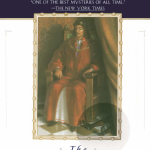Sometimes you go back to a book you remember with delight, and you wonder what you ever saw in it. Other times, you go back to a book you remember with a mild fondness…and discover that it’s wholly delightful. That’s been my experience recently as I revisit Dorothy Sayers’ tales of Lord Peter Wimsey; and the first of these is Whose Body?, which is in the public domain and can be found in any manner of places.
Whose Body? was published in 1923. Lord Peter, Sayers’ hero, is the younger brother of the Duke of Denver and a veteran of the Great War; and in Sayer’s own words a mixture of Bertie Wooster and Fred Astaire. Having suffered from what they called shellshock and what we call PTSD, Lord Peter has taken to sleuthing as a hobby. In the present outing, he’s presented with a problem by his mother, the Dowager Duchess of Denver: Mr. Thipps, the architect charged with repairing the roof of the church at Denver, walked into his bathroom that morning and found the bathtub occupied by a dead body, naked except for a pair of pince nez glasses. Where did the body come from? Who killed it? More to the point, who is it? And how on earth did it end up in Mr. Thipps’ bathroom?
In re-reading the first few Wimsey tales, I’ve been impressed at how fully formed the cast of characters is in this first book. We have Wimsey himself, who can spout the witty foolishness in best Wooster style, but always with a point; Wimsey’s solid and stolid friend, Police Inspector Charles Parker (because every amateur sleuth needs a friend on the force); Wimsey’s man Bunter, one of his noncoms during the war, who valets, butles, and photographs for him, and delights in chatting up housemaids and cooks; young man-about-town Freddie Arbuthnot, who seems to have escaped from a Georgette Heyer novel; and Wimsey’s mother, the Dowager Duchess, who is as outwardly goofy and inwardly astute as he is.
And there are so many things I missed in past readings. Wimsey’s foolishness is filled with classical and literary allusions, including many references to Lewis Carroll and Kai Lung; it’s like finding little jewels scattered hither and yon in odd places. And I’m reminded that Sayers was a contemporary of Chesterton and moved in the same intellectual currents. Her writing lacks the giddiness of Chesterton (she leaves that for Lord Peter’s dialog), but she addresses many of the same issues. In this book, for example, one of the suspects is the noted surgeon and free thinker Sir Julian Freke, who denies the reality of conscience on materialist grounds. I’d accuse her of cribbing from C.S. Lewis’ The Abolition of Man, except Lewis wrote his book twenty years later.
I’m not sure that Whose Body? is quite as good as its immediate successors; Lord Peter is perhaps a bit too goofy, and Sayers was getting her sea legs as a novelist. But I had great fun with it, and it’s definitely the place to start.











